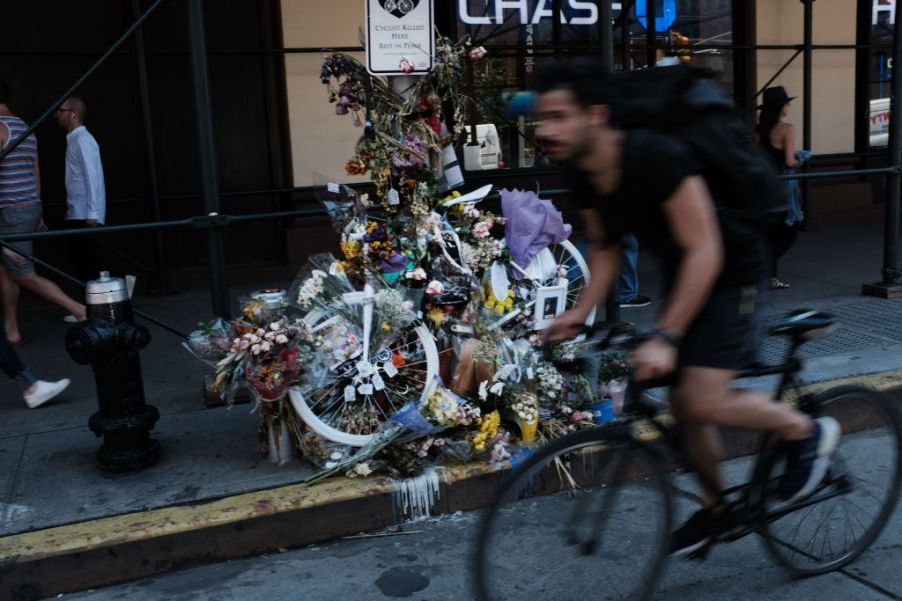
Drivers Slaughter More Cyclists Than They Have in 30 Years
Ostensibly, car safety is getting better every year. More and more cars, SUVs, and trucks have advanced driver-assistance features like emergency braking, blind-spot monitoring, and so on. This has culminated in 2019 being the third straight year of decreasing traffic deaths. However, there are signs that our current crash and safety standards have fallen dangerously behind the times. Especially since, even with many cars sitting idle due to COVID-19, cyclist deaths are at a 30-year high.
Cyclist deaths hit a 30-year high

This news comes courtesy of Autoblog, reporting on an ongoing data-gathering and reporting project run by Outside Magazine.
In 2019, the latest year for which data is available, drivers killed 846 cyclists in the US, The Bike Adviser states. That makes it the deadliest year for cyclists since 1990. Actually, not just for cyclists. Autoblog reports that, according to the Governors Highway Safety Association, pedestrian deaths in 2019 numbered 6590—again, a 30-year high. It was also 5% more pedestrian deaths than in 2018.
However, this isn’t an isolated anomaly, Outside notes. Cyclist deaths have been on the rise since 2010. And even accounting for population growth, pedestrian deaths from vehicle collisions have risen by over 26% since the early 2000s, Outside says.
And, despite the drop in traffic due to the COVID-19 pandemic, cyclist deaths continue to mount. Outside has developed an online tool to track cyclist deaths in the US. At the time of writing, 149 were recorded for 2020. Weirdly, though, traffic deaths have also risen.
Despite Massachusett’s DOT reporting a 50% decrease in April 2020 traffic, WBUR reports, fatalities have actually doubled. Which makes Georgia’s recent teen driver’s license ruling even more worrying. Not just that, but deaths are actually slightly up compared to April 2019. But if traffic deaths have allegedly been on the decline, why are they suddenly increasing? And why have cyclist and pedestrian deaths continued to rise?
Certainly, drivers and cyclists haven’t had the best relationship at the best of times. Even Scott “Scotty” Lagasse, Jr. and Dale Earnhardt, Jr., both NASCAR drivers and avid cyclists, have had drivers hurl vitriol at them, Bicycling reports. As a cyclist myself, I’ve been honked at, jeered at, and had drivers swerve too close to me. Several close friends have had racial slurs yelled at them. But angry drivers aren’t nearly the most pressing issue; it’s unsafe drivers.
Cyclist deaths and COVID-19 are exposing unsafe habits
Autoblog, Outside, and Bicycling Magazine all note that distracted driving has only increased over the years. If you’re looking at your phone, or even a navigation screen, you’re not paying attention to the road. But distracted driving is only part of the problem. Or, rather, it’s a symptom of a greater issue.
A 2006 study published in the British Medical Journal found that four-wheel-drive vehicle drivers were 4 times more likely to engage in distracted driving than other drivers. Many modern drivers—especially those in larger vehicles, like SUVs and trucks—don’t feel vulnerable. Their vehicles have so much mass, so many airbags, and sensors, that they’ve lost the sense of how dangerous driving can be. Worse, American crash standards haven’t really taken into account pedestrian safety, unlike European ones.
Although ADAS features have reduced accidents, they also make drivers complacent, AAA reports. 25% of drivers were comfortable doing other tasks while driving, so long as their vehicle had forward-collision or lane-departure warning. Also, 25% of drivers reported not doing visual checks if their vehicle had blind-spot monitoring.
But up to 80% of drivers, Forbes reports, didn’t know that forward-collision warning wasn’t the same as emergency braking. 1 in 3 didn’t know emergency braking systems relied on visual sensors that could be obscured by dirt, ice, or snow. And despite the marketing, no car on sale today is self-driving.
And this complacency has a cost, especially as the roads empty due to COVID-19. In California alone, The Drive reports, triple-digit speeding tickets tripled during the April lockdown. Drivers see relatively-empty roads, they think their fancy new car makes them invincible, and they speed. And then people die.
What can be done about this?
To be sure, cyclists and pedestrians do have their share of responsibilities. Pay attention to your surroundings. Obey local traffic signs and laws. In the case of cyclists, indicate your intentions, and use lights, especially at night.
However, vehicle drivers are responsible for keeping not only themselves and their passengers, but other road users and pedestrians safe. That means paying attention. Knowing and regularly checking your blind spots. Understanding that cyclists have a legal right to use the road. And overall, recognizing that just because you have the biggest vehicle, doesn’t mean you’re more important than everyone else.
Simple physics dictates that when truck, SUV, or car meets cyclists, the motor vehicle wins. Even if it’s not moving. Driving involves operating a potentially deadly machine. Just because you have airbags doesn’t mean everyone else does. Respect other road users, and everyone, cyclists included, will be able to get home safely.
Follow more updates from MotorBiscuit on our Facebook page.


